Analysis of Issues Regarding Green Building Policy Adoption
VerifiedAdded on 2021/04/21
|26
|5613
|74
Report
AI Summary
This report examines the issues surrounding the adoption of green building policies, focusing on challenges such as lack of knowledge and awareness, economic concerns, government barriers, and market attitudes within the Australian context. The study explores the importance of green buildings in promoting environmental protection and sustainability, considering their role in the construction industry. It delves into literature reviews, identifying the need for sustainable building practices and the barriers that hinder their implementation. The report also presents research methodologies including research questions, design analysis, surveys, and interviews to address the challenges. The report highlights the significance of green building technologies in promoting healthy lifestyles and protecting the environment and aims to provide effective recommendations for policymakers in planning and developing the construction industry.
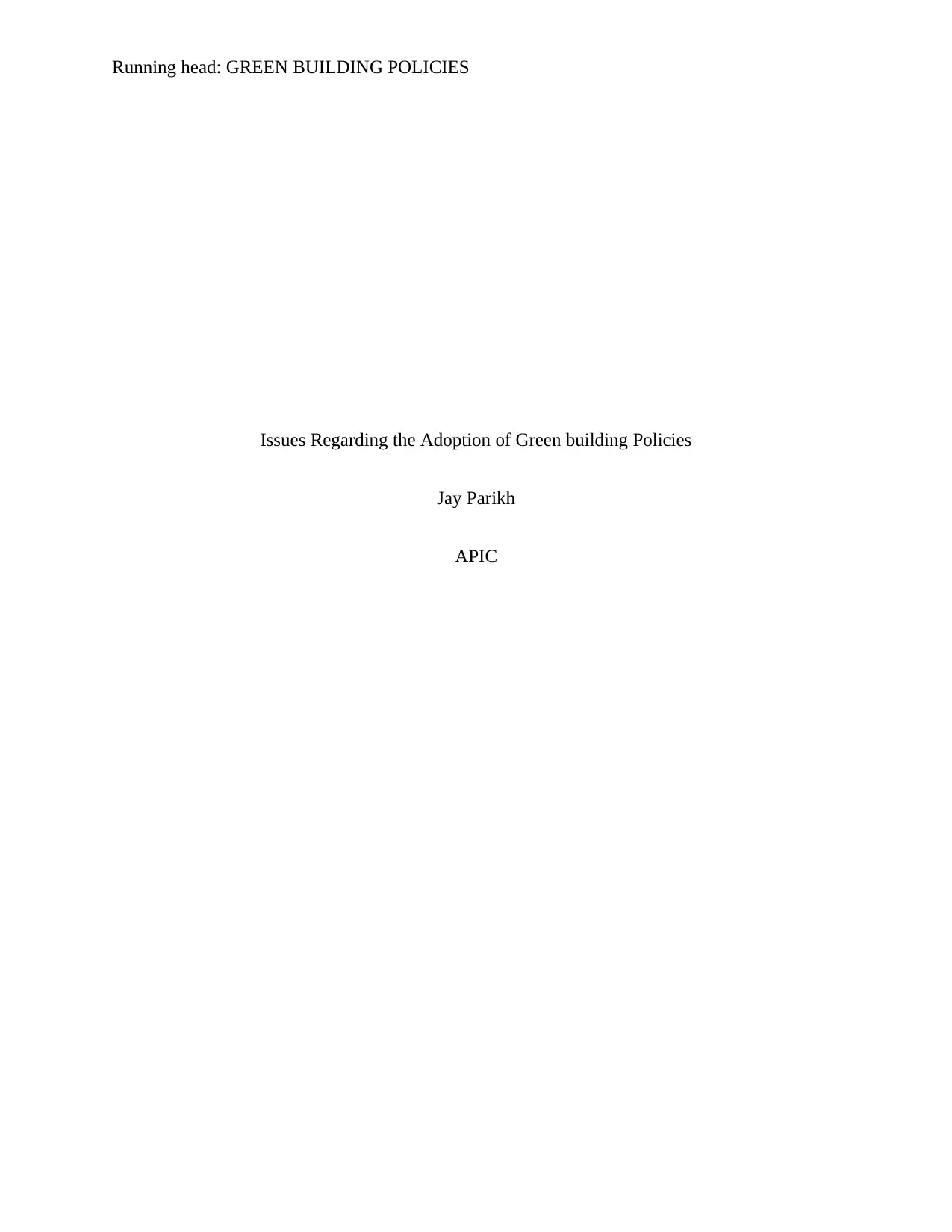
Running head: GREEN BUILDING POLICIES
Issues Regarding the Adoption of Green building Policies
Jay Parikh
APIC
Issues Regarding the Adoption of Green building Policies
Jay Parikh
APIC
Paraphrase This Document
Need a fresh take? Get an instant paraphrase of this document with our AI Paraphraser
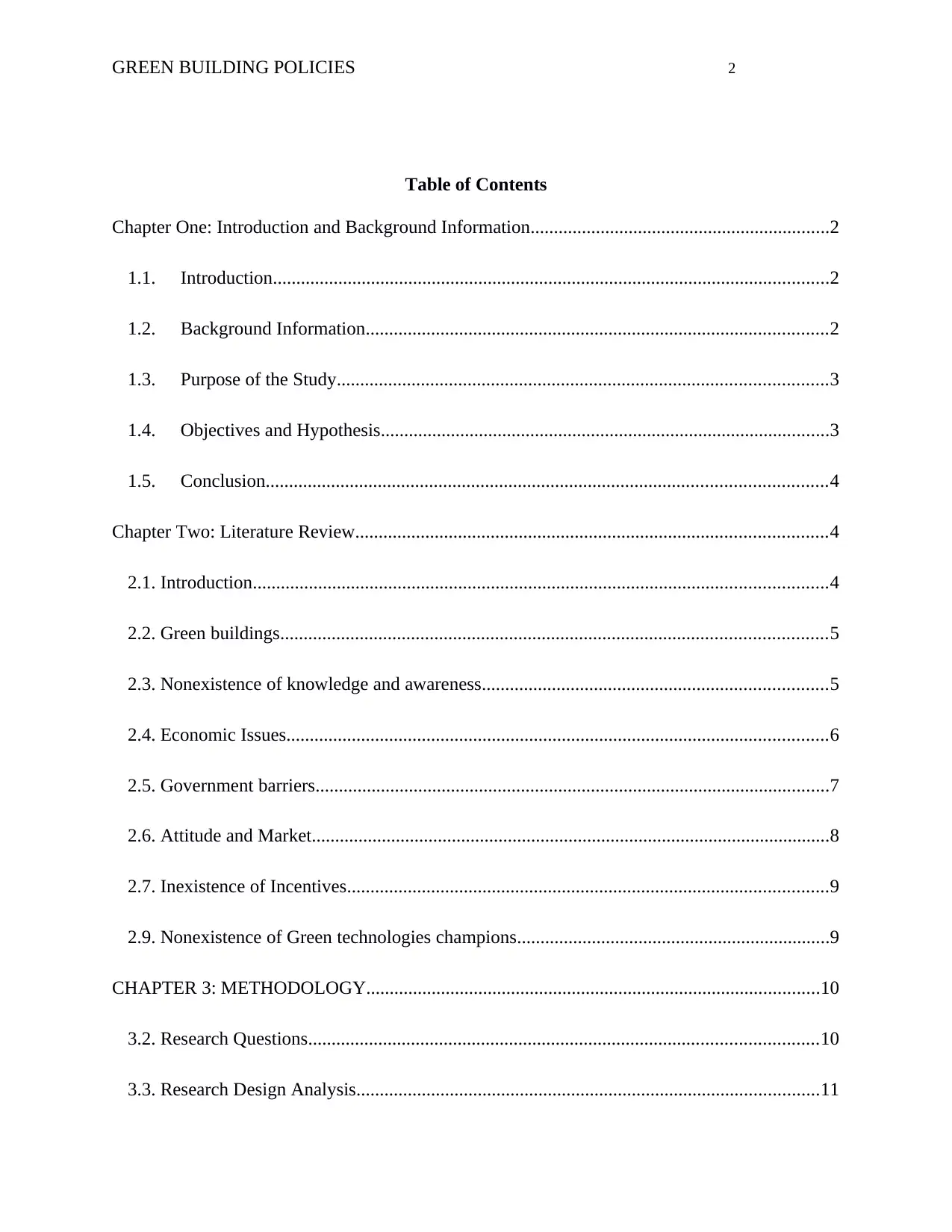
GREEN BUILDING POLICIES 2
Table of Contents
Chapter One: Introduction and Background Information................................................................2
1.1. Introduction.......................................................................................................................2
1.2. Background Information...................................................................................................2
1.3. Purpose of the Study.........................................................................................................3
1.4. Objectives and Hypothesis................................................................................................3
1.5. Conclusion........................................................................................................................4
Chapter Two: Literature Review.....................................................................................................4
2.1. Introduction...........................................................................................................................4
2.2. Green buildings.....................................................................................................................5
2.3. Nonexistence of knowledge and awareness..........................................................................5
2.4. Economic Issues....................................................................................................................6
2.5. Government barriers..............................................................................................................7
2.6. Attitude and Market...............................................................................................................8
2.7. Inexistence of Incentives.......................................................................................................9
2.9. Nonexistence of Green technologies champions...................................................................9
CHAPTER 3: METHODOLOGY.................................................................................................10
3.2. Research Questions.............................................................................................................10
3.3. Research Design Analysis...................................................................................................11
Table of Contents
Chapter One: Introduction and Background Information................................................................2
1.1. Introduction.......................................................................................................................2
1.2. Background Information...................................................................................................2
1.3. Purpose of the Study.........................................................................................................3
1.4. Objectives and Hypothesis................................................................................................3
1.5. Conclusion........................................................................................................................4
Chapter Two: Literature Review.....................................................................................................4
2.1. Introduction...........................................................................................................................4
2.2. Green buildings.....................................................................................................................5
2.3. Nonexistence of knowledge and awareness..........................................................................5
2.4. Economic Issues....................................................................................................................6
2.5. Government barriers..............................................................................................................7
2.6. Attitude and Market...............................................................................................................8
2.7. Inexistence of Incentives.......................................................................................................9
2.9. Nonexistence of Green technologies champions...................................................................9
CHAPTER 3: METHODOLOGY.................................................................................................10
3.2. Research Questions.............................................................................................................10
3.3. Research Design Analysis...................................................................................................11
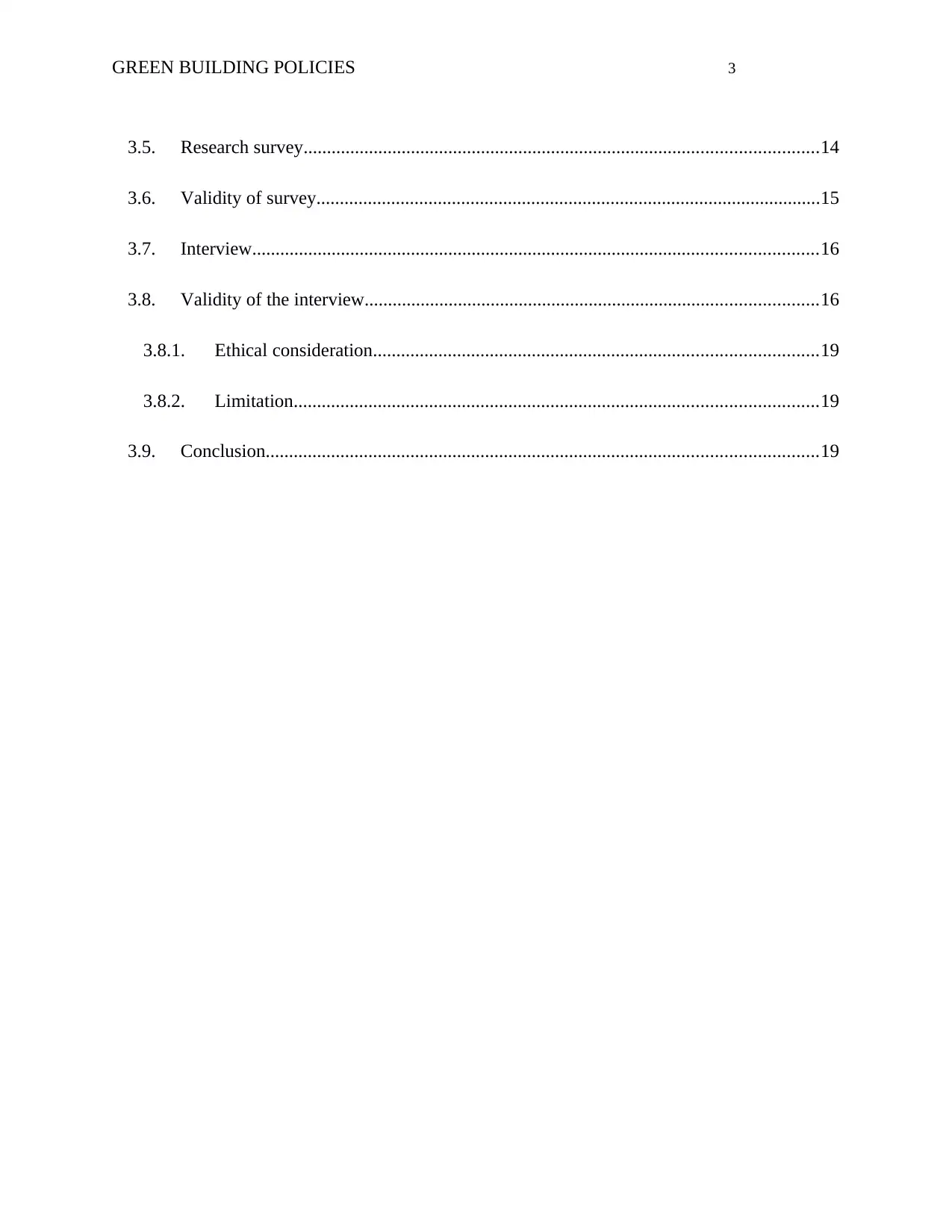
GREEN BUILDING POLICIES 3
3.5. Research survey..............................................................................................................14
3.6. Validity of survey............................................................................................................15
3.7. Interview.........................................................................................................................16
3.8. Validity of the interview.................................................................................................16
3.8.1. Ethical consideration...............................................................................................19
3.8.2. Limitation................................................................................................................19
3.9. Conclusion......................................................................................................................19
3.5. Research survey..............................................................................................................14
3.6. Validity of survey............................................................................................................15
3.7. Interview.........................................................................................................................16
3.8. Validity of the interview.................................................................................................16
3.8.1. Ethical consideration...............................................................................................19
3.8.2. Limitation................................................................................................................19
3.9. Conclusion......................................................................................................................19
⊘ This is a preview!⊘
Do you want full access?
Subscribe today to unlock all pages.

Trusted by 1+ million students worldwide
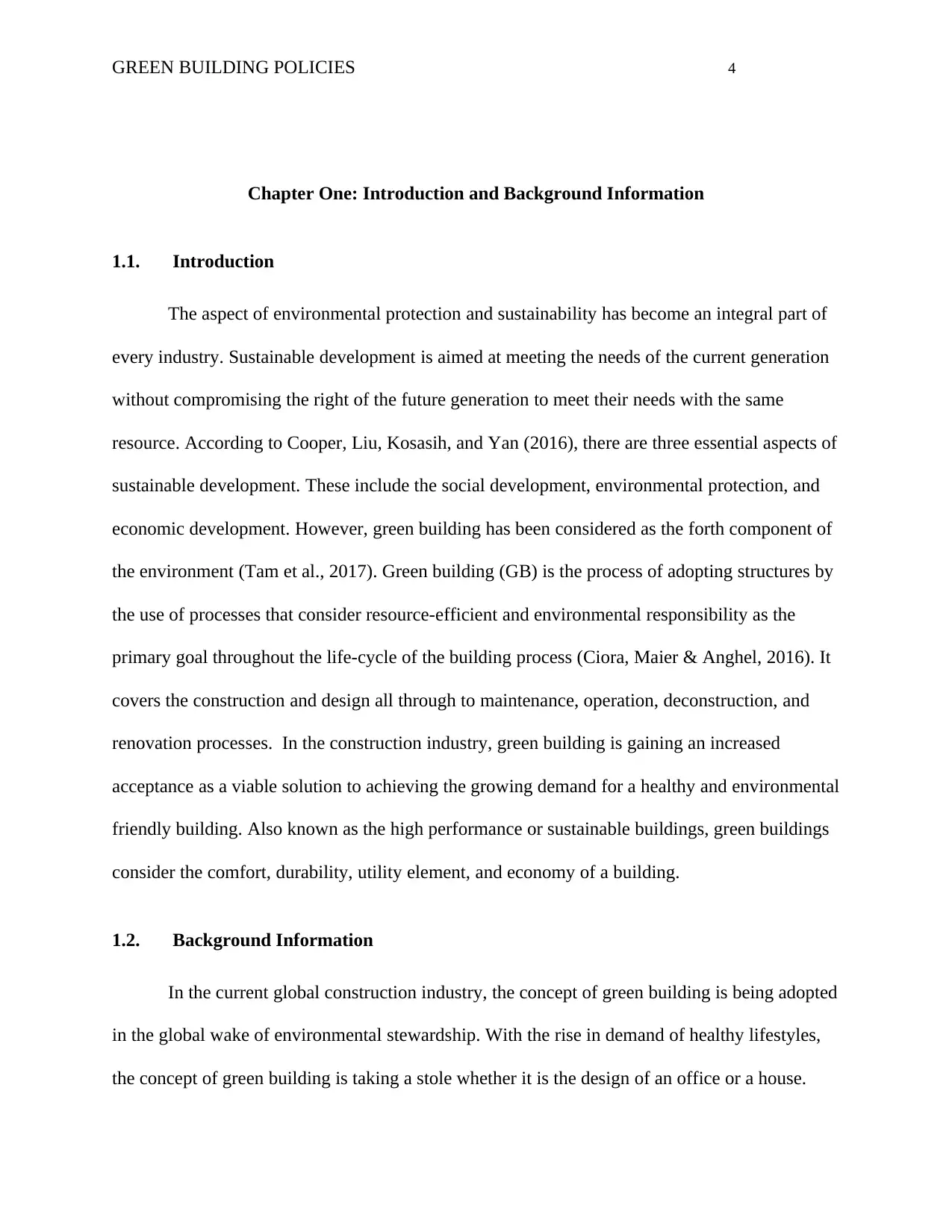
GREEN BUILDING POLICIES 4
Chapter One: Introduction and Background Information
1.1. Introduction
The aspect of environmental protection and sustainability has become an integral part of
every industry. Sustainable development is aimed at meeting the needs of the current generation
without compromising the right of the future generation to meet their needs with the same
resource. According to Cooper, Liu, Kosasih, and Yan (2016), there are three essential aspects of
sustainable development. These include the social development, environmental protection, and
economic development. However, green building has been considered as the forth component of
the environment (Tam et al., 2017). Green building (GB) is the process of adopting structures by
the use of processes that consider resource-efficient and environmental responsibility as the
primary goal throughout the life-cycle of the building process (Ciora, Maier & Anghel, 2016). It
covers the construction and design all through to maintenance, operation, deconstruction, and
renovation processes. In the construction industry, green building is gaining an increased
acceptance as a viable solution to achieving the growing demand for a healthy and environmental
friendly building. Also known as the high performance or sustainable buildings, green buildings
consider the comfort, durability, utility element, and economy of a building.
1.2. Background Information
In the current global construction industry, the concept of green building is being adopted
in the global wake of environmental stewardship. With the rise in demand of healthy lifestyles,
the concept of green building is taking a stole whether it is the design of an office or a house.
Chapter One: Introduction and Background Information
1.1. Introduction
The aspect of environmental protection and sustainability has become an integral part of
every industry. Sustainable development is aimed at meeting the needs of the current generation
without compromising the right of the future generation to meet their needs with the same
resource. According to Cooper, Liu, Kosasih, and Yan (2016), there are three essential aspects of
sustainable development. These include the social development, environmental protection, and
economic development. However, green building has been considered as the forth component of
the environment (Tam et al., 2017). Green building (GB) is the process of adopting structures by
the use of processes that consider resource-efficient and environmental responsibility as the
primary goal throughout the life-cycle of the building process (Ciora, Maier & Anghel, 2016). It
covers the construction and design all through to maintenance, operation, deconstruction, and
renovation processes. In the construction industry, green building is gaining an increased
acceptance as a viable solution to achieving the growing demand for a healthy and environmental
friendly building. Also known as the high performance or sustainable buildings, green buildings
consider the comfort, durability, utility element, and economy of a building.
1.2. Background Information
In the current global construction industry, the concept of green building is being adopted
in the global wake of environmental stewardship. With the rise in demand of healthy lifestyles,
the concept of green building is taking a stole whether it is the design of an office or a house.
Paraphrase This Document
Need a fresh take? Get an instant paraphrase of this document with our AI Paraphraser
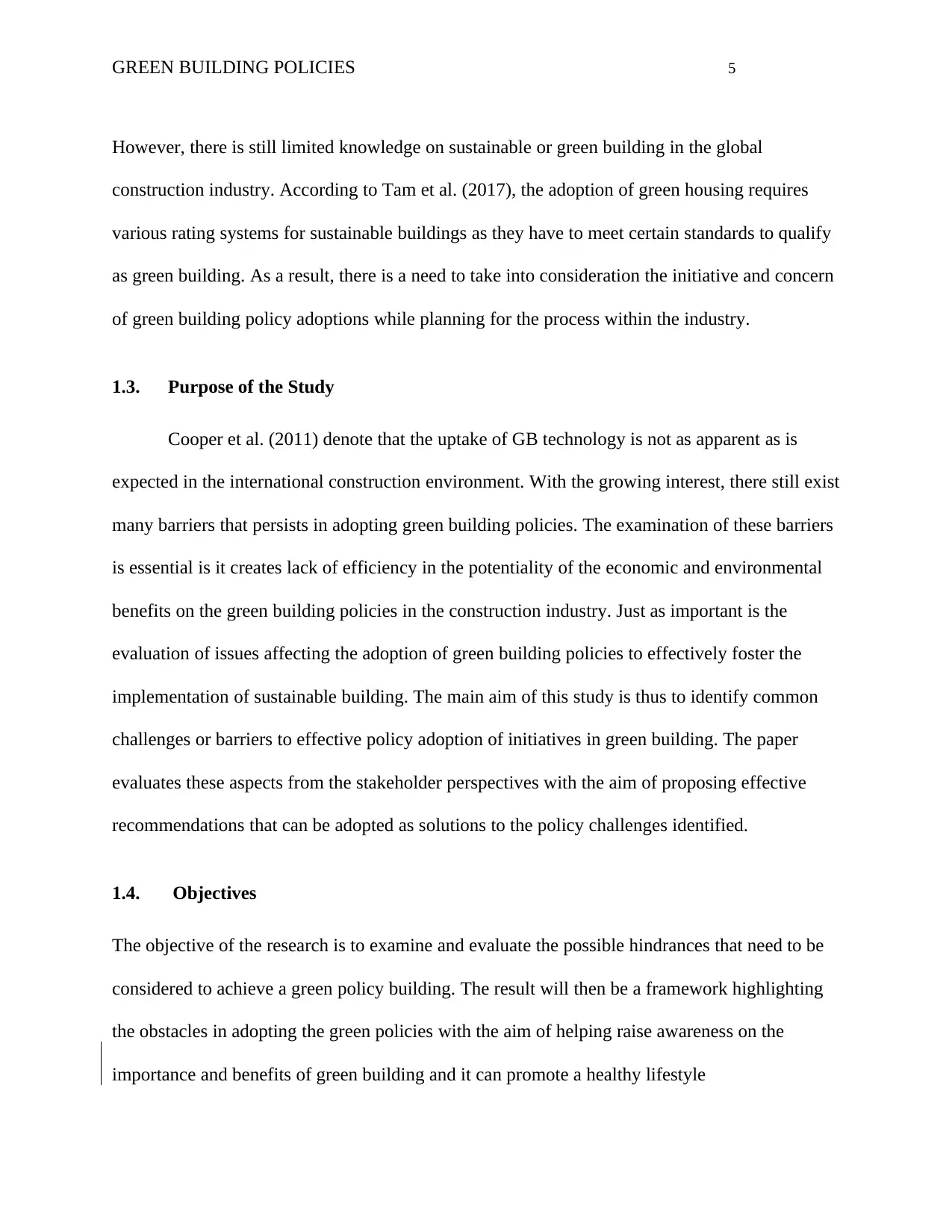
GREEN BUILDING POLICIES 5
However, there is still limited knowledge on sustainable or green building in the global
construction industry. According to Tam et al. (2017), the adoption of green housing requires
various rating systems for sustainable buildings as they have to meet certain standards to qualify
as green building. As a result, there is a need to take into consideration the initiative and concern
of green building policy adoptions while planning for the process within the industry.
1.3. Purpose of the Study
Cooper et al. (2011) denote that the uptake of GB technology is not as apparent as is
expected in the international construction environment. With the growing interest, there still exist
many barriers that persists in adopting green building policies. The examination of these barriers
is essential is it creates lack of efficiency in the potentiality of the economic and environmental
benefits on the green building policies in the construction industry. Just as important is the
evaluation of issues affecting the adoption of green building policies to effectively foster the
implementation of sustainable building. The main aim of this study is thus to identify common
challenges or barriers to effective policy adoption of initiatives in green building. The paper
evaluates these aspects from the stakeholder perspectives with the aim of proposing effective
recommendations that can be adopted as solutions to the policy challenges identified.
1.4. Objectives
The objective of the research is to examine and evaluate the possible hindrances that need to be
considered to achieve a green policy building. The result will then be a framework highlighting
the obstacles in adopting the green policies with the aim of helping raise awareness on the
importance and benefits of green building and it can promote a healthy lifestyle
However, there is still limited knowledge on sustainable or green building in the global
construction industry. According to Tam et al. (2017), the adoption of green housing requires
various rating systems for sustainable buildings as they have to meet certain standards to qualify
as green building. As a result, there is a need to take into consideration the initiative and concern
of green building policy adoptions while planning for the process within the industry.
1.3. Purpose of the Study
Cooper et al. (2011) denote that the uptake of GB technology is not as apparent as is
expected in the international construction environment. With the growing interest, there still exist
many barriers that persists in adopting green building policies. The examination of these barriers
is essential is it creates lack of efficiency in the potentiality of the economic and environmental
benefits on the green building policies in the construction industry. Just as important is the
evaluation of issues affecting the adoption of green building policies to effectively foster the
implementation of sustainable building. The main aim of this study is thus to identify common
challenges or barriers to effective policy adoption of initiatives in green building. The paper
evaluates these aspects from the stakeholder perspectives with the aim of proposing effective
recommendations that can be adopted as solutions to the policy challenges identified.
1.4. Objectives
The objective of the research is to examine and evaluate the possible hindrances that need to be
considered to achieve a green policy building. The result will then be a framework highlighting
the obstacles in adopting the green policies with the aim of helping raise awareness on the
importance and benefits of green building and it can promote a healthy lifestyle
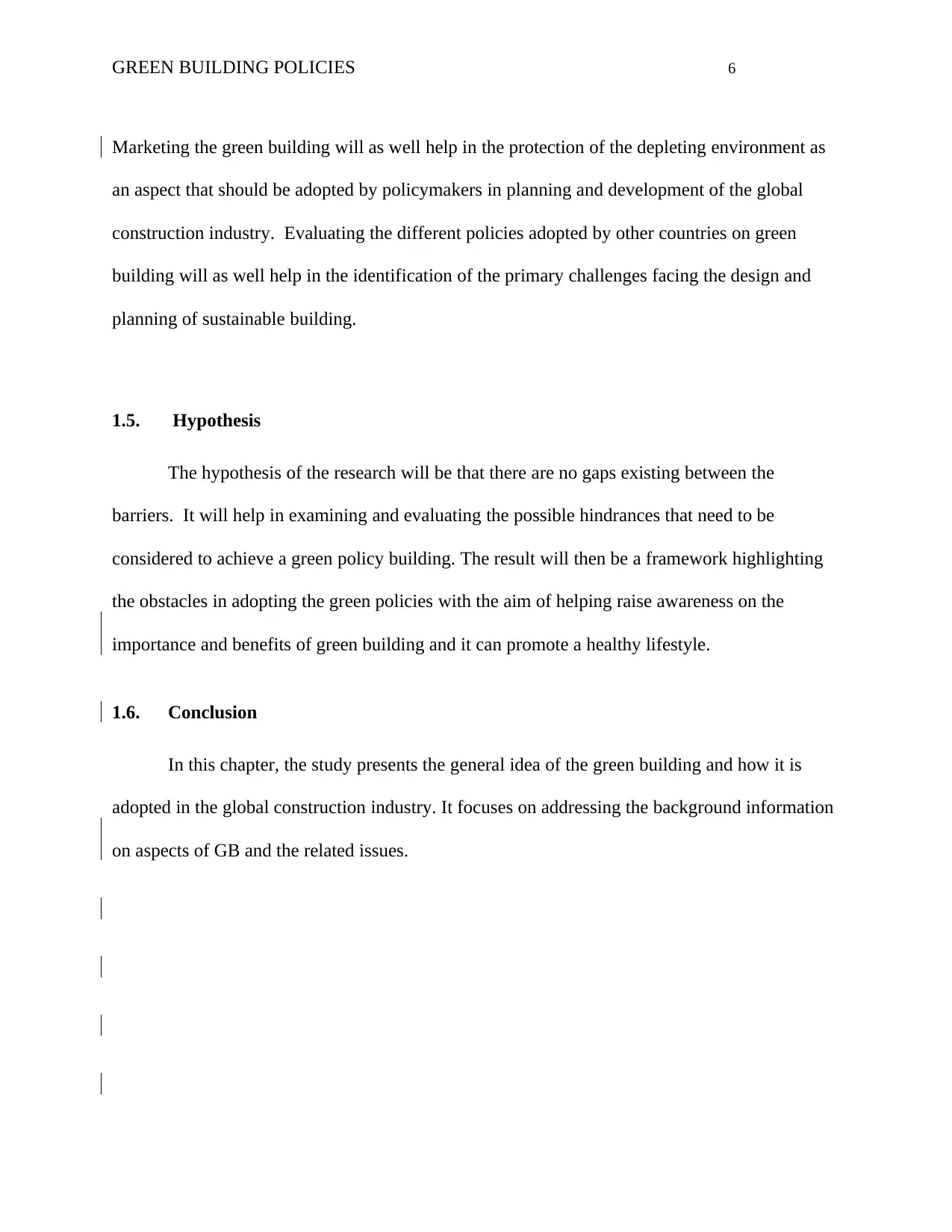
GREEN BUILDING POLICIES 6
Marketing the green building will as well help in the protection of the depleting environment as
an aspect that should be adopted by policymakers in planning and development of the global
construction industry. Evaluating the different policies adopted by other countries on green
building will as well help in the identification of the primary challenges facing the design and
planning of sustainable building.
1.5. Hypothesis
The hypothesis of the research will be that there are no gaps existing between the
barriers. It will help in examining and evaluating the possible hindrances that need to be
considered to achieve a green policy building. The result will then be a framework highlighting
the obstacles in adopting the green policies with the aim of helping raise awareness on the
importance and benefits of green building and it can promote a healthy lifestyle.
1.6. Conclusion
In this chapter, the study presents the general idea of the green building and how it is
adopted in the global construction industry. It focuses on addressing the background information
on aspects of GB and the related issues.
Marketing the green building will as well help in the protection of the depleting environment as
an aspect that should be adopted by policymakers in planning and development of the global
construction industry. Evaluating the different policies adopted by other countries on green
building will as well help in the identification of the primary challenges facing the design and
planning of sustainable building.
1.5. Hypothesis
The hypothesis of the research will be that there are no gaps existing between the
barriers. It will help in examining and evaluating the possible hindrances that need to be
considered to achieve a green policy building. The result will then be a framework highlighting
the obstacles in adopting the green policies with the aim of helping raise awareness on the
importance and benefits of green building and it can promote a healthy lifestyle.
1.6. Conclusion
In this chapter, the study presents the general idea of the green building and how it is
adopted in the global construction industry. It focuses on addressing the background information
on aspects of GB and the related issues.
⊘ This is a preview!⊘
Do you want full access?
Subscribe today to unlock all pages.

Trusted by 1+ million students worldwide
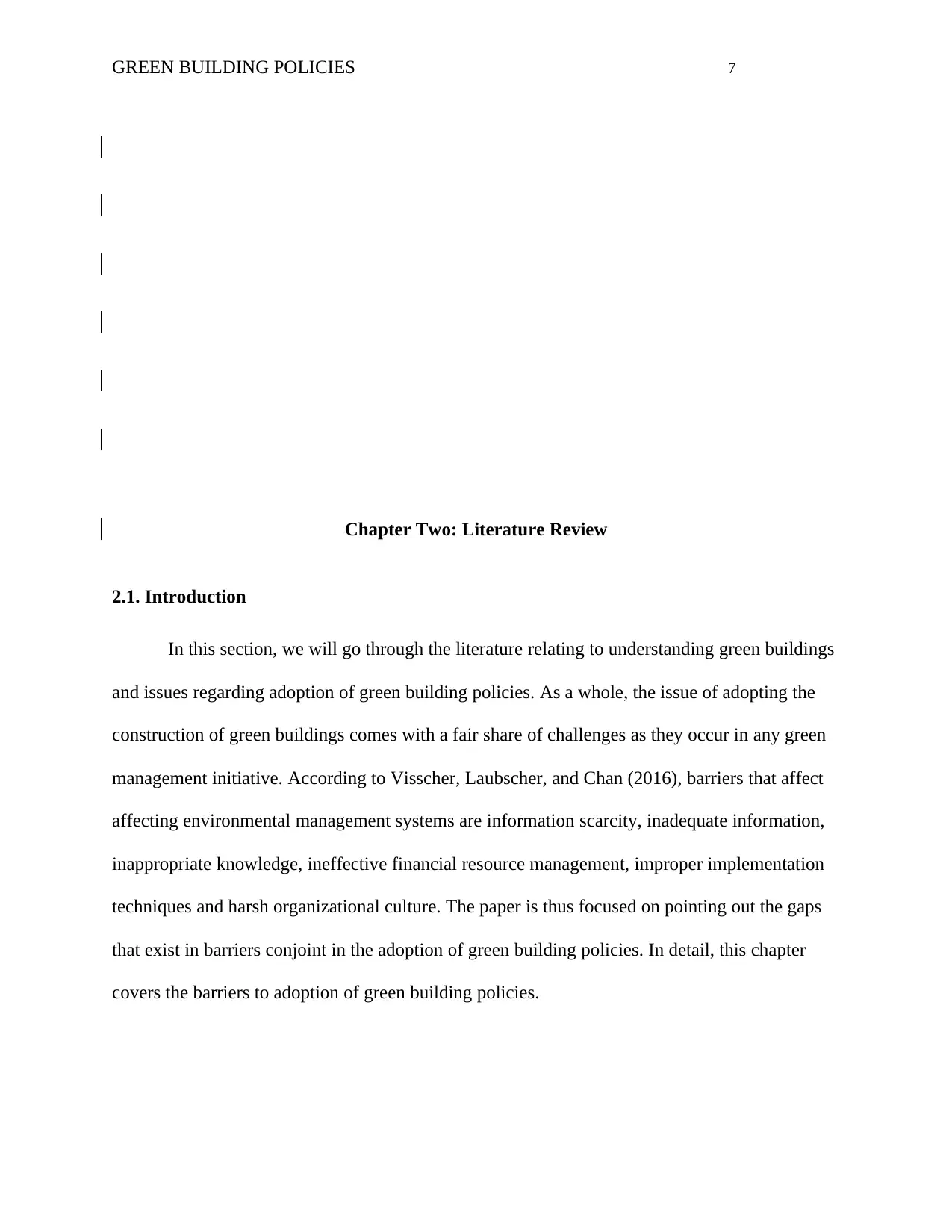
GREEN BUILDING POLICIES 7
Chapter Two: Literature Review
2.1. Introduction
In this section, we will go through the literature relating to understanding green buildings
and issues regarding adoption of green building policies. As a whole, the issue of adopting the
construction of green buildings comes with a fair share of challenges as they occur in any green
management initiative. According to Visscher, Laubscher, and Chan (2016), barriers that affect
affecting environmental management systems are information scarcity, inadequate information,
inappropriate knowledge, ineffective financial resource management, improper implementation
techniques and harsh organizational culture. The paper is thus focused on pointing out the gaps
that exist in barriers conjoint in the adoption of green building policies. In detail, this chapter
covers the barriers to adoption of green building policies.
Chapter Two: Literature Review
2.1. Introduction
In this section, we will go through the literature relating to understanding green buildings
and issues regarding adoption of green building policies. As a whole, the issue of adopting the
construction of green buildings comes with a fair share of challenges as they occur in any green
management initiative. According to Visscher, Laubscher, and Chan (2016), barriers that affect
affecting environmental management systems are information scarcity, inadequate information,
inappropriate knowledge, ineffective financial resource management, improper implementation
techniques and harsh organizational culture. The paper is thus focused on pointing out the gaps
that exist in barriers conjoint in the adoption of green building policies. In detail, this chapter
covers the barriers to adoption of green building policies.
Paraphrase This Document
Need a fresh take? Get an instant paraphrase of this document with our AI Paraphraser
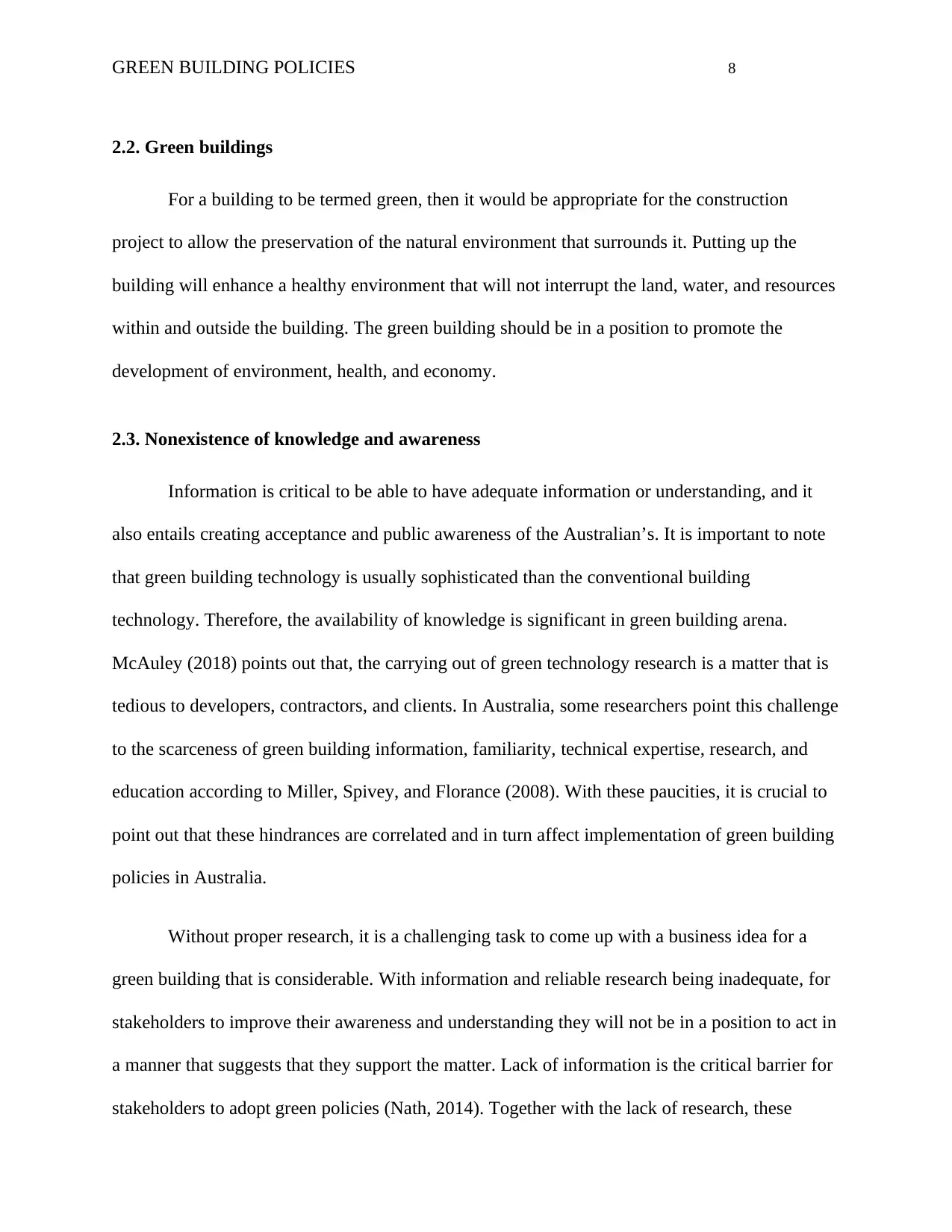
GREEN BUILDING POLICIES 8
2.2. Green buildings
For a building to be termed green, then it would be appropriate for the construction
project to allow the preservation of the natural environment that surrounds it. Putting up the
building will enhance a healthy environment that will not interrupt the land, water, and resources
within and outside the building. The green building should be in a position to promote the
development of environment, health, and economy.
2.3. Nonexistence of knowledge and awareness
Information is critical to be able to have adequate information or understanding, and it
also entails creating acceptance and public awareness of the Australian’s. It is important to note
that green building technology is usually sophisticated than the conventional building
technology. Therefore, the availability of knowledge is significant in green building arena.
McAuley (2018) points out that, the carrying out of green technology research is a matter that is
tedious to developers, contractors, and clients. In Australia, some researchers point this challenge
to the scarceness of green building information, familiarity, technical expertise, research, and
education according to Miller, Spivey, and Florance (2008). With these paucities, it is crucial to
point out that these hindrances are correlated and in turn affect implementation of green building
policies in Australia.
Without proper research, it is a challenging task to come up with a business idea for a
green building that is considerable. With information and reliable research being inadequate, for
stakeholders to improve their awareness and understanding they will not be in a position to act in
a manner that suggests that they support the matter. Lack of information is the critical barrier for
stakeholders to adopt green policies (Nath, 2014). Together with the lack of research, these
2.2. Green buildings
For a building to be termed green, then it would be appropriate for the construction
project to allow the preservation of the natural environment that surrounds it. Putting up the
building will enhance a healthy environment that will not interrupt the land, water, and resources
within and outside the building. The green building should be in a position to promote the
development of environment, health, and economy.
2.3. Nonexistence of knowledge and awareness
Information is critical to be able to have adequate information or understanding, and it
also entails creating acceptance and public awareness of the Australian’s. It is important to note
that green building technology is usually sophisticated than the conventional building
technology. Therefore, the availability of knowledge is significant in green building arena.
McAuley (2018) points out that, the carrying out of green technology research is a matter that is
tedious to developers, contractors, and clients. In Australia, some researchers point this challenge
to the scarceness of green building information, familiarity, technical expertise, research, and
education according to Miller, Spivey, and Florance (2008). With these paucities, it is crucial to
point out that these hindrances are correlated and in turn affect implementation of green building
policies in Australia.
Without proper research, it is a challenging task to come up with a business idea for a
green building that is considerable. With information and reliable research being inadequate, for
stakeholders to improve their awareness and understanding they will not be in a position to act in
a manner that suggests that they support the matter. Lack of information is the critical barrier for
stakeholders to adopt green policies (Nath, 2014). Together with the lack of research, these
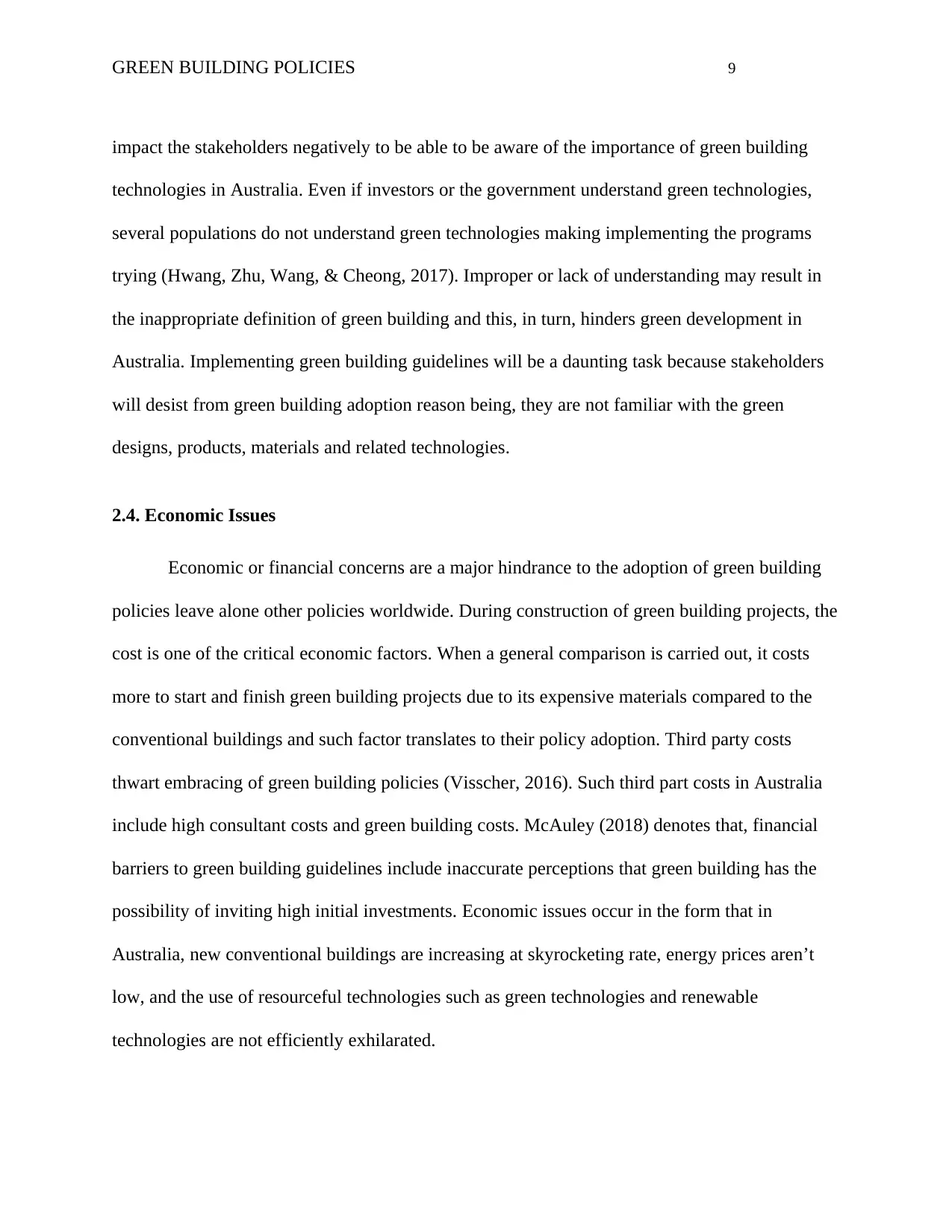
GREEN BUILDING POLICIES 9
impact the stakeholders negatively to be able to be aware of the importance of green building
technologies in Australia. Even if investors or the government understand green technologies,
several populations do not understand green technologies making implementing the programs
trying (Hwang, Zhu, Wang, & Cheong, 2017). Improper or lack of understanding may result in
the inappropriate definition of green building and this, in turn, hinders green development in
Australia. Implementing green building guidelines will be a daunting task because stakeholders
will desist from green building adoption reason being, they are not familiar with the green
designs, products, materials and related technologies.
2.4. Economic Issues
Economic or financial concerns are a major hindrance to the adoption of green building
policies leave alone other policies worldwide. During construction of green building projects, the
cost is one of the critical economic factors. When a general comparison is carried out, it costs
more to start and finish green building projects due to its expensive materials compared to the
conventional buildings and such factor translates to their policy adoption. Third party costs
thwart embracing of green building policies (Visscher, 2016). Such third part costs in Australia
include high consultant costs and green building costs. McAuley (2018) denotes that, financial
barriers to green building guidelines include inaccurate perceptions that green building has the
possibility of inviting high initial investments. Economic issues occur in the form that in
Australia, new conventional buildings are increasing at skyrocketing rate, energy prices aren’t
low, and the use of resourceful technologies such as green technologies and renewable
technologies are not efficiently exhilarated.
impact the stakeholders negatively to be able to be aware of the importance of green building
technologies in Australia. Even if investors or the government understand green technologies,
several populations do not understand green technologies making implementing the programs
trying (Hwang, Zhu, Wang, & Cheong, 2017). Improper or lack of understanding may result in
the inappropriate definition of green building and this, in turn, hinders green development in
Australia. Implementing green building guidelines will be a daunting task because stakeholders
will desist from green building adoption reason being, they are not familiar with the green
designs, products, materials and related technologies.
2.4. Economic Issues
Economic or financial concerns are a major hindrance to the adoption of green building
policies leave alone other policies worldwide. During construction of green building projects, the
cost is one of the critical economic factors. When a general comparison is carried out, it costs
more to start and finish green building projects due to its expensive materials compared to the
conventional buildings and such factor translates to their policy adoption. Third party costs
thwart embracing of green building policies (Visscher, 2016). Such third part costs in Australia
include high consultant costs and green building costs. McAuley (2018) denotes that, financial
barriers to green building guidelines include inaccurate perceptions that green building has the
possibility of inviting high initial investments. Economic issues occur in the form that in
Australia, new conventional buildings are increasing at skyrocketing rate, energy prices aren’t
low, and the use of resourceful technologies such as green technologies and renewable
technologies are not efficiently exhilarated.
⊘ This is a preview!⊘
Do you want full access?
Subscribe today to unlock all pages.

Trusted by 1+ million students worldwide
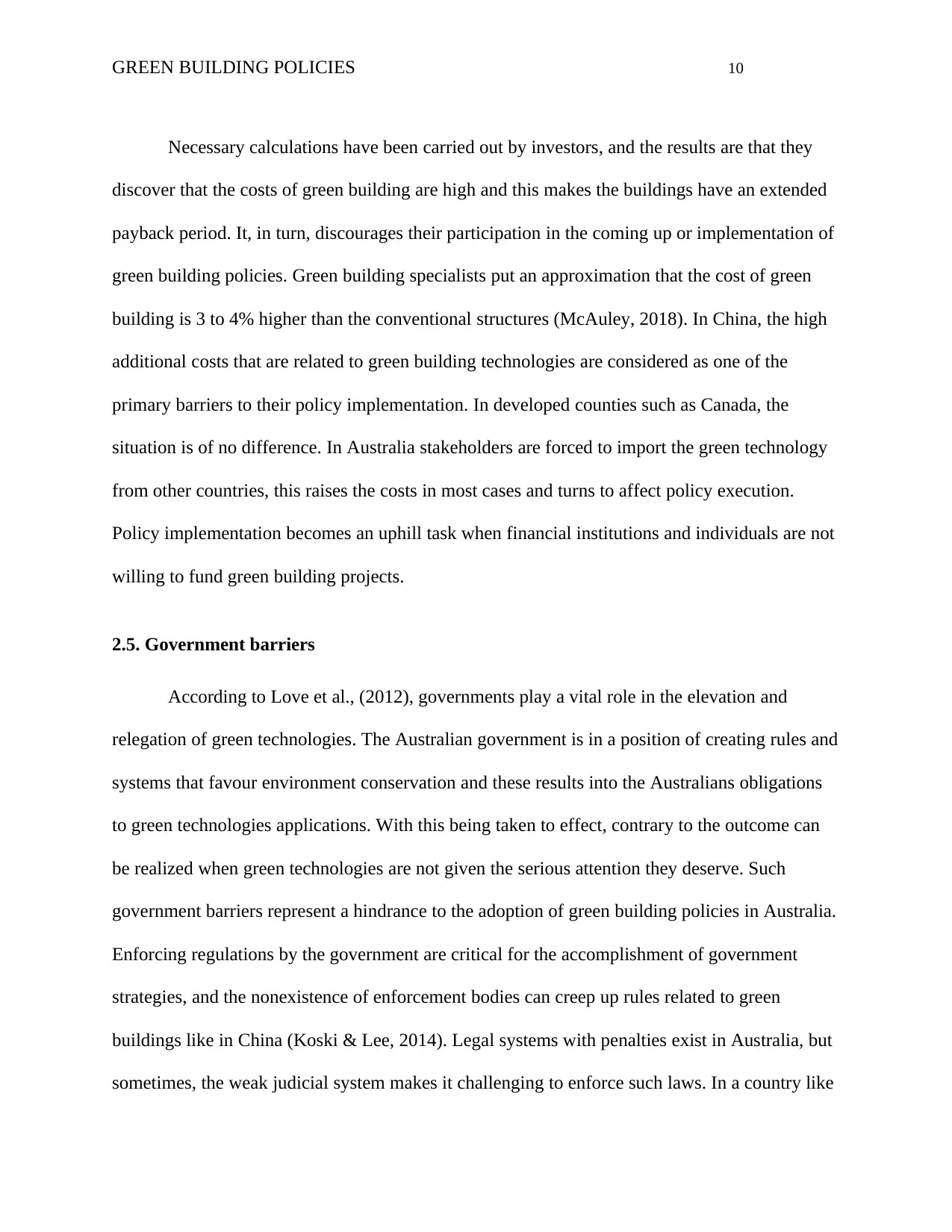
GREEN BUILDING POLICIES 10
Necessary calculations have been carried out by investors, and the results are that they
discover that the costs of green building are high and this makes the buildings have an extended
payback period. It, in turn, discourages their participation in the coming up or implementation of
green building policies. Green building specialists put an approximation that the cost of green
building is 3 to 4% higher than the conventional structures (McAuley, 2018). In China, the high
additional costs that are related to green building technologies are considered as one of the
primary barriers to their policy implementation. In developed counties such as Canada, the
situation is of no difference. In Australia stakeholders are forced to import the green technology
from other countries, this raises the costs in most cases and turns to affect policy execution.
Policy implementation becomes an uphill task when financial institutions and individuals are not
willing to fund green building projects.
2.5. Government barriers
According to Love et al., (2012), governments play a vital role in the elevation and
relegation of green technologies. The Australian government is in a position of creating rules and
systems that favour environment conservation and these results into the Australians obligations
to green technologies applications. With this being taken to effect, contrary to the outcome can
be realized when green technologies are not given the serious attention they deserve. Such
government barriers represent a hindrance to the adoption of green building policies in Australia.
Enforcing regulations by the government are critical for the accomplishment of government
strategies, and the nonexistence of enforcement bodies can creep up rules related to green
buildings like in China (Koski & Lee, 2014). Legal systems with penalties exist in Australia, but
sometimes, the weak judicial system makes it challenging to enforce such laws. In a country like
Necessary calculations have been carried out by investors, and the results are that they
discover that the costs of green building are high and this makes the buildings have an extended
payback period. It, in turn, discourages their participation in the coming up or implementation of
green building policies. Green building specialists put an approximation that the cost of green
building is 3 to 4% higher than the conventional structures (McAuley, 2018). In China, the high
additional costs that are related to green building technologies are considered as one of the
primary barriers to their policy implementation. In developed counties such as Canada, the
situation is of no difference. In Australia stakeholders are forced to import the green technology
from other countries, this raises the costs in most cases and turns to affect policy execution.
Policy implementation becomes an uphill task when financial institutions and individuals are not
willing to fund green building projects.
2.5. Government barriers
According to Love et al., (2012), governments play a vital role in the elevation and
relegation of green technologies. The Australian government is in a position of creating rules and
systems that favour environment conservation and these results into the Australians obligations
to green technologies applications. With this being taken to effect, contrary to the outcome can
be realized when green technologies are not given the serious attention they deserve. Such
government barriers represent a hindrance to the adoption of green building policies in Australia.
Enforcing regulations by the government are critical for the accomplishment of government
strategies, and the nonexistence of enforcement bodies can creep up rules related to green
buildings like in China (Koski & Lee, 2014). Legal systems with penalties exist in Australia, but
sometimes, the weak judicial system makes it challenging to enforce such laws. In a country like
Paraphrase This Document
Need a fresh take? Get an instant paraphrase of this document with our AI Paraphraser
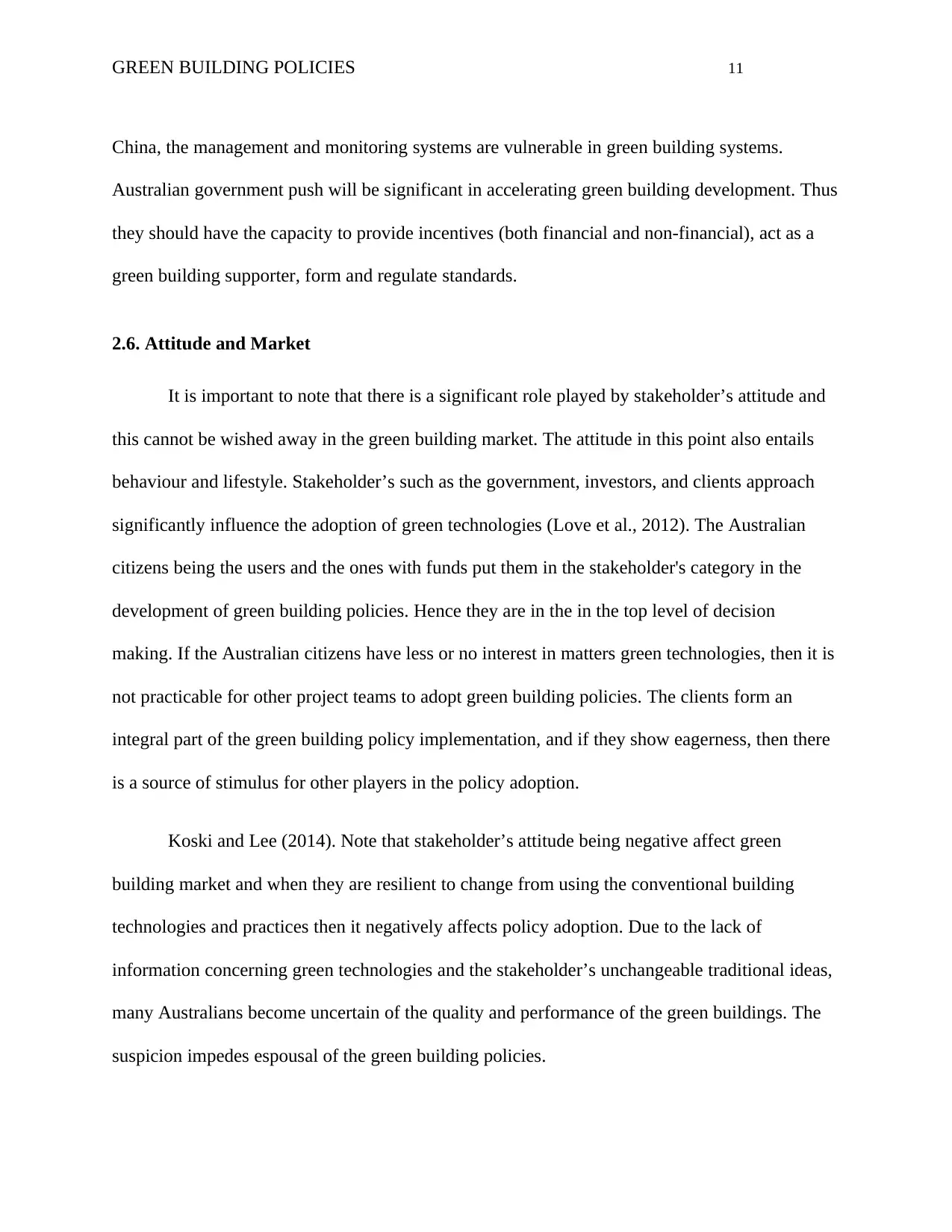
GREEN BUILDING POLICIES 11
China, the management and monitoring systems are vulnerable in green building systems.
Australian government push will be significant in accelerating green building development. Thus
they should have the capacity to provide incentives (both financial and non-financial), act as a
green building supporter, form and regulate standards.
2.6. Attitude and Market
It is important to note that there is a significant role played by stakeholder’s attitude and
this cannot be wished away in the green building market. The attitude in this point also entails
behaviour and lifestyle. Stakeholder’s such as the government, investors, and clients approach
significantly influence the adoption of green technologies (Love et al., 2012). The Australian
citizens being the users and the ones with funds put them in the stakeholder's category in the
development of green building policies. Hence they are in the in the top level of decision
making. If the Australian citizens have less or no interest in matters green technologies, then it is
not practicable for other project teams to adopt green building policies. The clients form an
integral part of the green building policy implementation, and if they show eagerness, then there
is a source of stimulus for other players in the policy adoption.
Koski and Lee (2014). Note that stakeholder’s attitude being negative affect green
building market and when they are resilient to change from using the conventional building
technologies and practices then it negatively affects policy adoption. Due to the lack of
information concerning green technologies and the stakeholder’s unchangeable traditional ideas,
many Australians become uncertain of the quality and performance of the green buildings. The
suspicion impedes espousal of the green building policies.
China, the management and monitoring systems are vulnerable in green building systems.
Australian government push will be significant in accelerating green building development. Thus
they should have the capacity to provide incentives (both financial and non-financial), act as a
green building supporter, form and regulate standards.
2.6. Attitude and Market
It is important to note that there is a significant role played by stakeholder’s attitude and
this cannot be wished away in the green building market. The attitude in this point also entails
behaviour and lifestyle. Stakeholder’s such as the government, investors, and clients approach
significantly influence the adoption of green technologies (Love et al., 2012). The Australian
citizens being the users and the ones with funds put them in the stakeholder's category in the
development of green building policies. Hence they are in the in the top level of decision
making. If the Australian citizens have less or no interest in matters green technologies, then it is
not practicable for other project teams to adopt green building policies. The clients form an
integral part of the green building policy implementation, and if they show eagerness, then there
is a source of stimulus for other players in the policy adoption.
Koski and Lee (2014). Note that stakeholder’s attitude being negative affect green
building market and when they are resilient to change from using the conventional building
technologies and practices then it negatively affects policy adoption. Due to the lack of
information concerning green technologies and the stakeholder’s unchangeable traditional ideas,
many Australians become uncertain of the quality and performance of the green buildings. The
suspicion impedes espousal of the green building policies.
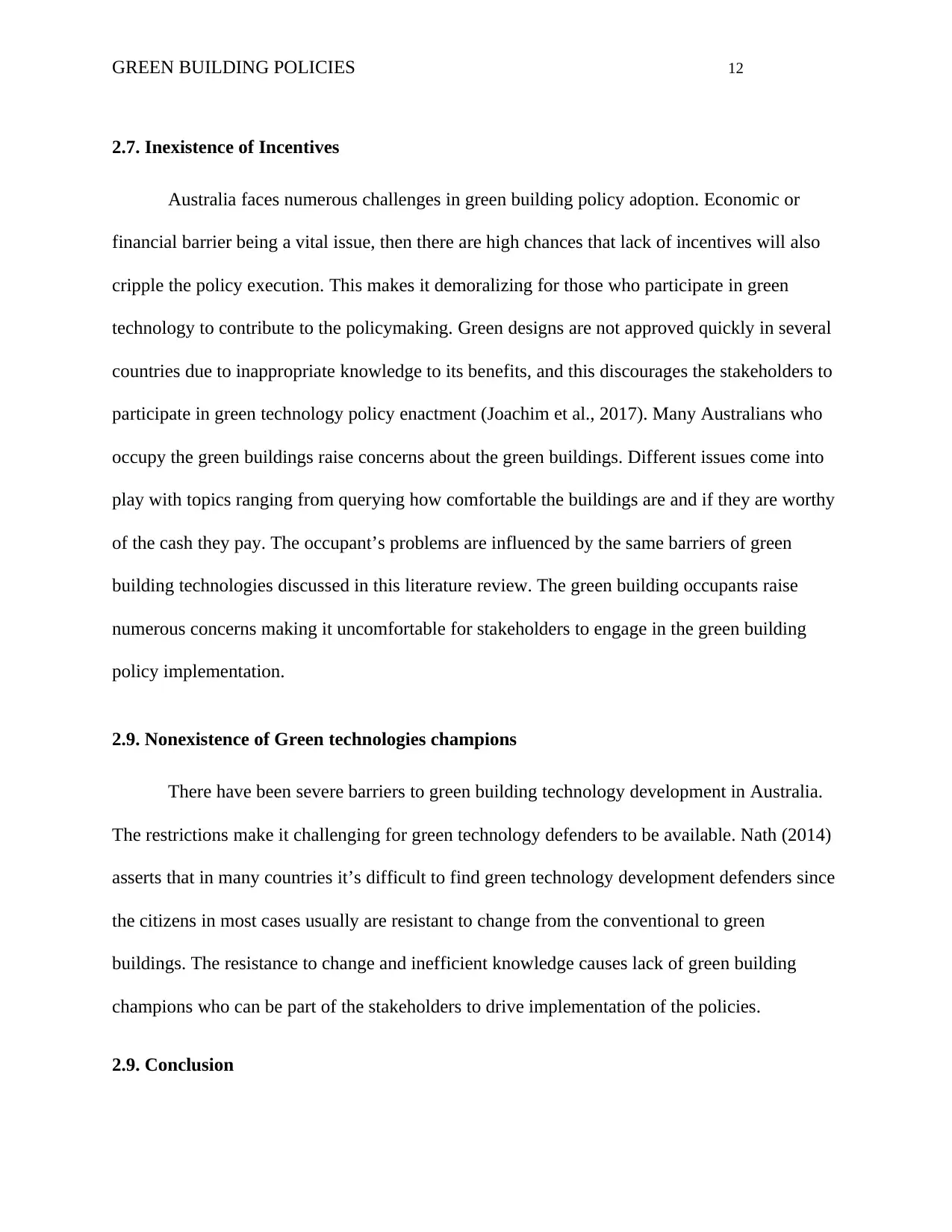
GREEN BUILDING POLICIES 12
2.7. Inexistence of Incentives
Australia faces numerous challenges in green building policy adoption. Economic or
financial barrier being a vital issue, then there are high chances that lack of incentives will also
cripple the policy execution. This makes it demoralizing for those who participate in green
technology to contribute to the policymaking. Green designs are not approved quickly in several
countries due to inappropriate knowledge to its benefits, and this discourages the stakeholders to
participate in green technology policy enactment (Joachim et al., 2017). Many Australians who
occupy the green buildings raise concerns about the green buildings. Different issues come into
play with topics ranging from querying how comfortable the buildings are and if they are worthy
of the cash they pay. The occupant’s problems are influenced by the same barriers of green
building technologies discussed in this literature review. The green building occupants raise
numerous concerns making it uncomfortable for stakeholders to engage in the green building
policy implementation.
2.9. Nonexistence of Green technologies champions
There have been severe barriers to green building technology development in Australia.
The restrictions make it challenging for green technology defenders to be available. Nath (2014)
asserts that in many countries it’s difficult to find green technology development defenders since
the citizens in most cases usually are resistant to change from the conventional to green
buildings. The resistance to change and inefficient knowledge causes lack of green building
champions who can be part of the stakeholders to drive implementation of the policies.
2.9. Conclusion
2.7. Inexistence of Incentives
Australia faces numerous challenges in green building policy adoption. Economic or
financial barrier being a vital issue, then there are high chances that lack of incentives will also
cripple the policy execution. This makes it demoralizing for those who participate in green
technology to contribute to the policymaking. Green designs are not approved quickly in several
countries due to inappropriate knowledge to its benefits, and this discourages the stakeholders to
participate in green technology policy enactment (Joachim et al., 2017). Many Australians who
occupy the green buildings raise concerns about the green buildings. Different issues come into
play with topics ranging from querying how comfortable the buildings are and if they are worthy
of the cash they pay. The occupant’s problems are influenced by the same barriers of green
building technologies discussed in this literature review. The green building occupants raise
numerous concerns making it uncomfortable for stakeholders to engage in the green building
policy implementation.
2.9. Nonexistence of Green technologies champions
There have been severe barriers to green building technology development in Australia.
The restrictions make it challenging for green technology defenders to be available. Nath (2014)
asserts that in many countries it’s difficult to find green technology development defenders since
the citizens in most cases usually are resistant to change from the conventional to green
buildings. The resistance to change and inefficient knowledge causes lack of green building
champions who can be part of the stakeholders to drive implementation of the policies.
2.9. Conclusion
⊘ This is a preview!⊘
Do you want full access?
Subscribe today to unlock all pages.

Trusted by 1+ million students worldwide
1 out of 26
Related Documents
Your All-in-One AI-Powered Toolkit for Academic Success.
+13062052269
info@desklib.com
Available 24*7 on WhatsApp / Email
![[object Object]](/_next/static/media/star-bottom.7253800d.svg)
Unlock your academic potential
Copyright © 2020–2025 A2Z Services. All Rights Reserved. Developed and managed by ZUCOL.




